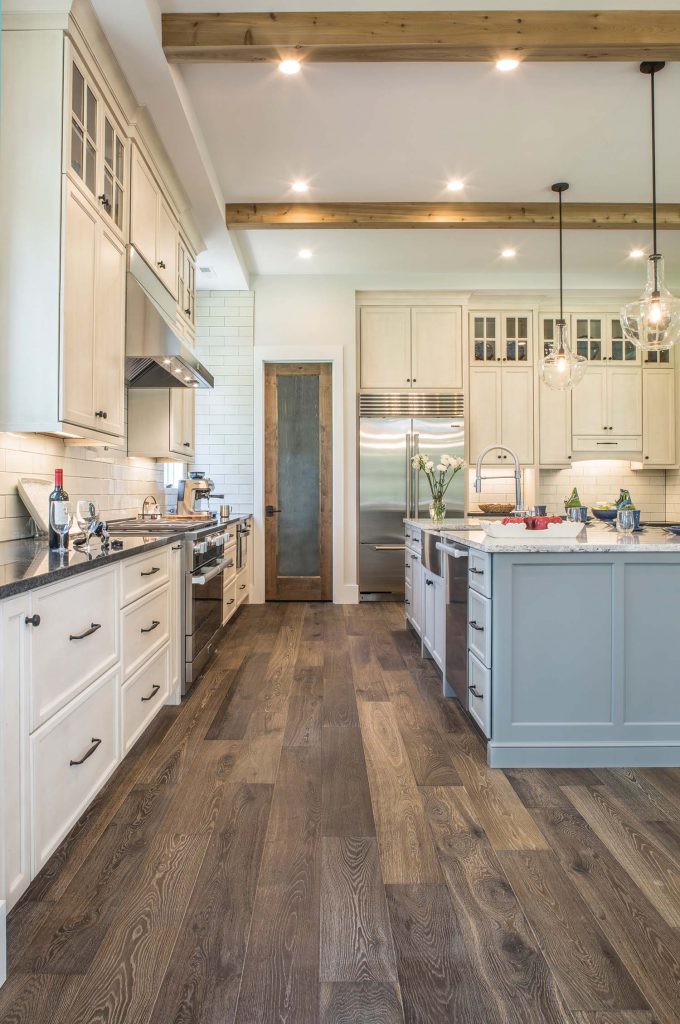Packard featured in Carolina Home magazine
October 15, 2019Source: https://carolinahg.com/someday-is-now/
Even if you’re not a Julia Child wannabe, you still deserve a “tremendously interesting” kitchen, to paraphrase the late culinary icon. Today’s open layouts allow for kitchens to be equal parts sustenance preparation center and friend-and-family gathering spot. “I’m not a big cook, but I’m one of five kids and have lots of family in Florida,” notes Texas transplant Heather Norton.
Horton became familiar with Western North Carolina through family golfing vacations growing up. “It was always gorgeous here, and the weather!” she enthuses. “We dreamed of coming here someday, after the kids went to college. My husband [Sean] retired, so ‘someday’ is now.”
For their new full-time residence in Fairview, Horton craved a shift toward rusticity; their Texas digs were French Country-influenced. She classifies their mountain home as primarily “elegant farmhouse.” The open plan places the kitchen next to the family room and a breakfast area, where, Horton says, “I look forward to gathering with everyone. My other goal was to, as much as possible, bring the stunning view inside.”
Horton calls the design process and craftsmanship “an amazing team effort involving many moving parts.” Osada Construction Manager David Tanner and Site Supervisor Andy Reynolds oversaw the project with Packard Cabinetry designer Robin C. Weeter. “My hat’s off to Rob — I don’t know what I would’ve done without him,” says Horton. (Packard partner Kevin Smith also provided expertise.)
Weeter’s 34 years in design encompasses everything from HUD projects to owning showrooms that served the Aspen and Vail markets, and accompanying billionaire clients to Europe for cabinet design and finish selection. With Heather and Sean, “we started with a room that was well thought out from the get-go,” says Weeter. “I also loved that the land led the project, instead of the structure.”
The kitchen is elegant but welcoming. “We had dark cabinets before, so my first thought was bright white,” shares Horton. However, “instead of bright and glossy, I suggested we go with off-white [a brushed ‘Villa Marshmallow’ glaze],” says Weeter. What he calls this “new twist on antiquing” gives the Fieldstone cabinets, with their Stratford-style doors, a European vibe — “but doesn’t sacrifice the illumination Heather sought,” he explains. Horton also wanted a non-“matchy-matchy” island, so Weeter steered her toward a blue-gray base (“Shale”-tinted varnish), topped with a Cambria “Summerhill” black-and-silver-speckled creamy quartz top, which complements the “Steel Grey” granite countertops and oversized, white-marble subway-tile backsplash. “The grays and silvers were gentler than high-contrast black,” observes Horton.
She next assigned Weeter the task of incorporating a desk into the kitchen. He acknowledges the challenge: “[Kitchen desks] usually face a wall, become messy, and can seem like an afterthought.” So he engineered varying counter heights, a drop-down letter holder above an arched furniture valance, and an open appliance niche separating the desk from the refrigerator. “The way he designed the desk cabinetry with rounded edges was genius,” says Horton.
The Miele, Sub-Zero, and Sharp appliances offer high performance combined with industrial-modern chic. “The appliances placement is more ‘small kitchen,’ but the entertainment zone’s ample. The oven’s steam feature makes whatever you cook come out great, even if you’re not the most skilled chef,” says Horton. Weeter notes that the Kraus stainless-steel bowl front-apron sink, as opposed to the oft-used fireclay farmhouse type, was “the unorthodox but more beautiful choice.”

Photo by David Dietrich
Understatedly luxe finishes throughout elevate the room via a subtle gleam: Horton dubs the backsplash tiles’ sheen “extra special,” and transparent pendant lights epitomize grace and utility. Forgoing window treatments allows the outside in even more. Striking rustic counterpoints include European oak flooring with texture-infusing color variations and gray cedar ceiling beams that, in Weeter’s estimation, offer “a great foil to the darker floor.” The uppermost cabinet doors are glass and counter the ceiling height. Horton’s reserving them for a display of colorful glass pieces.
Weeter incorporated a range of life-easing features: soft-close cabinetry, below-cabinet task lighting, a pot-filler faucet, and easy-to-access spice-pantry pullouts that flank each side of the range.
Though the designer/homeowner duo clearly worked in harmony, their takes on the space’s ultimate vibe are distinct. Weeter finds the space “calming — not ‘in your face’ — in the best sense.” But the kitchen makes Horton feel energized. “It’s like a sunny day,” she says.